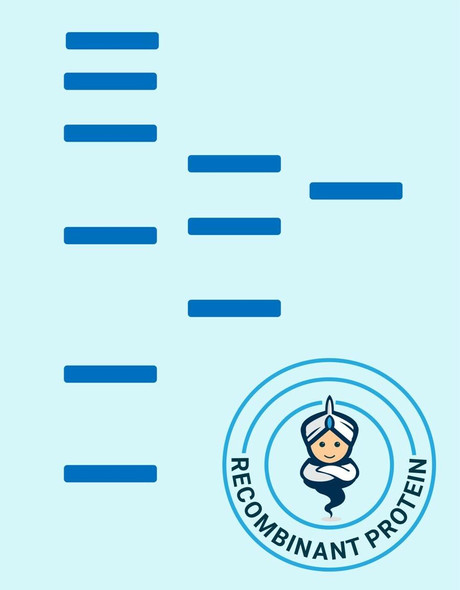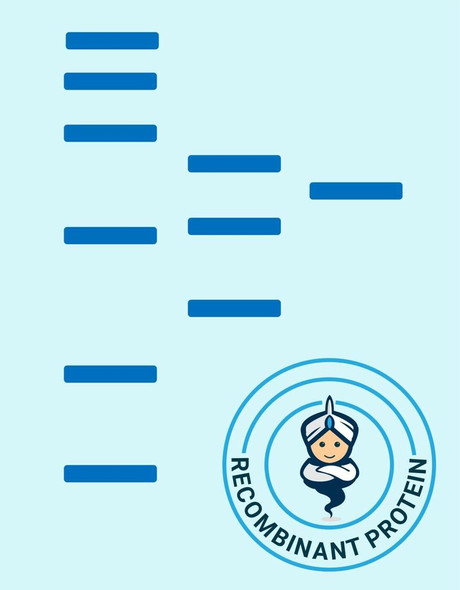Description
| Product Name: | Human PHB Recombinant Protein |
| Product Code: | RPPB4239 |
| Size: | 10µg |
| Species: | Human |
| Target: | PHB |
| Synonyms: | PHB1, Prohibitin. |
| Source: | Escherichia Coli |
| Physical Appearance: | Sterile Filtered colorless solution. |
| Formulation: | PHB protein solution (1mg/ml) containing 20mM Tris-HCl buffer (pH8.0), 10% glycerol and 0.1M NaCl. |
| Stability: | Store at 4°C if entire vial will be used within 2-4 weeks. Store, frozen at -20°C for longer periods of time. For long term storage it is recommended to add a carrier protein (0.1% HSA or BSA).Avoid multiple freeze-thaw cycles. |
| Purity: | Greater than 85% as determined by SDS-PAGE. |
| Amino Acid Sequence: | MGSSHHHHHH SSGLVPRGSH MAAKVFESIG KFGLALAVAG GVVNSALYNV DAGHRAVIFD RFRGVQDIVV GEGTHFLIPW VQKPIIFDCR SRPRNVPVIT GSKDLQNVNI TLRILFRPVA SQLPRIFTSI GEDYDERVLP SITTEILKSV VARFDAGELI TQRELVSRQV SDDLTERAAT FGLILDDVSL THLTFGKEFT EAVEAKQVAQ QEAERARFVV EKAEQQKKAA IISAEGDSKA AELIANSLAT AGDGLIELRK LEAAEDIAYQ LSRSRNITYL PAGQSVLLQL PQ |
Prohibitin (PHB) is an evolutionarily conserved gene that is ubiquitously expressed and which Mutations have been linked to sporadic breast cancer. PHB is thought to be a negative regulator of cell proliferation and may be a tumor suppressor. Prohibitin is expressed as two transcripts with changeable lengths of 3' untranslated region. The longer transcript is present at higher levels in proliferating tissues and cells, proposing that this longer 3' untranslated region functions as a trans-acting regulatory RNA.
PHB Human Recombinant produced in E.Coli is a single, non-glycosylated polypeptide chain containing 292 amino acids (1-272a.a) and having a molecular mass of 31.9kDa. PHB is fused to a 20 amino acid His-tag at N-terminus & purified by proprietary chromatographic techniques.
| UniProt Protein Function: | PHB: a pleiotropic membrane protein that suppresses cell proliferation, apoptosis and senescence. It plays a role both in maintaining mitochondrial integrity and in cell cycle regulation. Expression increases approximately 3-fold upon entry into G1 phase compared with other phases of the cell cycle. It helps prevent ROS-induced senescence and its expression decreases heterogeneously during cellular aging. Helps maintain the angiogenic capacity of endothelial cells. Up-regulated during activation of primary human T cells via CD3/CD28 pathways. Present in multiple cellular compartments. Large assemblies of PHB and PHB2 localize in the inner membrane of mitochondria. Acts as a mitochondrial chaperone protein, regulates mitochondrial morphogenesis, and helps regulate the organization of mitochondrial DNA. Reported to target lipid rafts. In the nucleus, it has been reported to interact with various transcription factors, modulating their activity. A potential tumor suppressor that functions as a potent transcriptional corepressor for estrogen receptor alpha. It is downregulated by androgens, and represses androgen receptor activity. Co-localizes with Rb in the nucleus and recruits N-CoR and HDAC1 for transcriptional repression. In vivo promoter occupancy studies have suggested that the PHB gene is a direct target of c-Myc. May bind to and enhance the transcriptional activity of p53. Both Phb and Phb2 are present in the circulation and can be internalized by cultured cells. Overexpressed in endometrioid ovarian adenocarcinoma and papillary serous ovarian carcinoma. Mutated in sporadic breast cancer. |
| UniProt Protein Details: | Protein type:Oncoprotein; Cell cycle regulation; Mitochondrial; Chaperone; Motility/polarity/chemotaxis; Transcription, coactivator/corepressor; Nuclear receptor co-regulator; Apoptosis Chromosomal Location of Human Ortholog: 17q21 Cellular Component: nucleoplasm; membrane; mitochondrion; integral to plasma membrane; mitochondrial inner membrane; cytoplasm; nucleus Molecular Function:protein binding; enzyme binding; histone deacetylase binding Biological Process: osteoblast differentiation; regulation of apoptosis; transcription from RNA polymerase II promoter; negative regulation of cell proliferation; progesterone receptor signaling pathway; regulation of transcription, DNA-dependent; positive regulation of transcription, DNA-dependent; histone deacetylation; negative regulation of cell growth; negative regulation of transcription from RNA polymerase II promoter; signal transduction; negative regulation of transcription, DNA-dependent Disease: Breast Cancer |
| NCBI Summary: | This gene is evolutionarily conserved, and its product is proposed to play a role in human cellular senescence and tumor suppression. Antiproliferative activity is reported to be localized to the 3' UTR, which is proposed to function as a trans-acting regulatory RNA. Several pseudogenes of this gene have been identified. Alternative splicing results in multiple transcript variants. [provided by RefSeq, Jul 2013] |
| UniProt Code: | P35232 |
| NCBI GenInfo Identifier: | 464371 |
| NCBI Gene ID: | 5245 |
| NCBI Accession: | P35232.1 |
| UniProt Secondary Accession: | P35232,Q4VBQ0, B4DY47, |
| UniProt Related Accession: | P35232 |
| Molecular Weight: | 272 |
| NCBI Full Name: | Prohibitin |
| NCBI Synonym Full Names: | prohibitin |
| NCBI Official Symbol: | PHB�� |
| NCBI Official Synonym Symbols: | PHB1; HEL-215; HEL-S-54e�� |
| NCBI Protein Information: | prohibitin; epididymis luminal protein 215; epididymis secretory sperm binding protein Li 54e |
| UniProt Protein Name: | Prohibitin |
| Protein Family: | Prohibitin |
| UniProt Gene Name: | PHB�� |
| UniProt Entry Name: | PHB_HUMAN |






